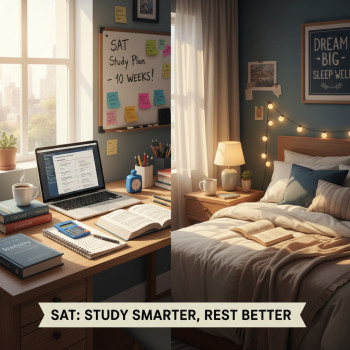Can Parents See SAT Score Reports Directly? A Clear, Calm Guide for Students and Families
Why this matters — and why you should read on
College applications feel like a relay race: students run, parents cheer (and sometimes sprint beside them), counselors hand off important forms, and colleges watch the finish line. In that mix, SAT scores often feel like a baton — essential, anxiously awaited, and wrapped in questions about who actually sees the score and when.
If you’re a student or a parent preparing for the Digital SAT and the college application process, you’re probably asking one of the most practical questions: can parents see SAT score reports directly? Short answer: not automatically — and the details matter. This article walks you through the rules, how score reporting works in practice today, how families can coordinate securely, and what to do if you need help getting or sharing scores. Along the way I’ll offer real-world examples, comparisons, and useful actions so you leave with a clear plan.

How SAT scores are shared — the basics
The College Board, the organization that administers the SAT, has defined processes for who receives score information and how it’s delivered. Scores are sent to:
- Colleges and scholarship programs that a student chooses to send their scores to.
- The student’s high school and, in many cases, the student’s district or state education agency (for aggregates and reporting).
- Authorized educators and institutional staff who have specific reporting portal roles.
Importantly, the student is at the center of score control. Unless a student takes a step to provide access or share scores, parents don’t automatically get a direct copy of the student’s College Board score report through the College Board systems simply because they are parents.
Difference between individual score reports and aggregate reports
There are two flavors of what organizations can see:
- Aggregate reports: These provide school- or district-level summaries and are intended for educators to see trends and group performance without focusing on single students.
- Individual student reports: These include an individual’s scores, detailed subscores, and sometimes section-level insights. Access to these is restricted and assigned through professional accounts with specific roles.
Who can see individual student SAT score reports?
Here’s what typically holds true today, in plain language:
- The student: Students can always access their own scores through their College Board account and BigFuture tools. They control which colleges receive scores and can download PDF score reports for their records.
- Colleges and programs the student chooses: When a student requests score sends during registration or after testing, those institutions receive the score reports directly.
- School district or state staff with authorized roles: Educators and administrators whose institutions have been granted access to the K–12 reporting portal may be able to view individual student scores — but only if their account has the specific role (e.g., Detailed Reports role) assigned. Access managers at the school or district level manage those roles.
- Parents: Parents do not automatically receive student score reports through College Board systems simply because they are parents. If a student shares login information (not recommended) or provides the report directly, parents can see it. Otherwise, the student can share or authorize the distribution to colleges and other organizations they choose.
Practical example
Imagine Maria, a junior who took the Digital SAT at school. Her school district receives aggregate data for analysis. The district’s testing coordinator, with Summary Reports access, can view district-level trends but not Maria’s individual scores. Maria’s counselor, however, has the Detailed Reports role and can pull Maria’s PDF score report to discuss college options with her — but only if the counselor’s institution gave them that access and the student’s data is available in the portal.
How students can share SAT results with parents safely and effectively
Families want transparency and support — and students want control and privacy. These goals can coexist with simple, respectful practices:
- Students download and share the official PDF: The easiest, most straightforward method is for the student to log into their College Board account, download the official score report PDF, and deliver it to parents. This preserves control and is immediate.
- Use the BigFuture School app or student notification channels: When students opt to receive scores via the BigFuture School app (where available), they’ll get notifications. Students can then choose to forward results to parents or show them directly.
- Set up a family plan for communication: Decide ahead of time how scores will be shared. Will the student share immediately? After a debrief? Only after discussing next steps? Clear expectations reduce friction and hurt feelings.
- If school staff need to see the scores: Students can give permission verbally and work with counselors to review results together — schools usually have established policies for counselor-student meetings and parental involvement.
Why not just share College Board login details?
It might be tempting for a parent to ask for a student’s login so they can check scores directly. Don’t do this. Sharing account credentials undermines student privacy, can violate terms of service, and leaves the account vulnerable. Instead, rely on the PDF-share method, guided counselor access, or official channels that respect student control.
What to do if you’re a parent and you can’t see a report
If you’re a parent and you don’t have the student’s score PDF, here’s a step-by-step path to a solution that respects privacy and gets you the information you need.
- Talk first. Ask your student to share their score PDF or to meet with you and the counselor. Approach this as a team conversation, not an interrogation.
- Invite the counselor into the conversation. School counselors can access individual reports if they have the right role and can facilitate sharing in a structured way.
- If your student applied to colleges and you’re concerned about whether scores were sent, check the student’s application portals (Common App, college portals) together and confirm score recipients in their College Board account.
- For legal guardianship or exceptional cases (e.g., younger students or district policies), contact the school’s access manager — they control who receives K–12 reporting portal roles.
Table: Quick reference — who can view SAT scores and how
| Viewer | Typical Access | How Access Happens |
|---|---|---|
| Student | Full access to personal scores | College Board account, BigFuture, downloadable PDF |
| Parent (by default) | No direct access | Only if student shares PDF or shows parent |
| College/Scholarship programs | Access to scores sent by student | Scores sent by student during registration or after testing |
| School counselor / Educator | May have access if assigned Detailed Reports role | Institution grants role via access manager |
| District / State | Aggregate and sometimes individual (role-dependent) | Portal access assigned to district/state accounts |
Privacy and consent: the student is in charge
Modern testing and college planning put students at the center of score control. There are several reasons for this design:
- Legal and privacy considerations: Educational records and student data are protected; systems are built to respect student consent and minimize unauthorized access.
- Practical fairness: Many students manage sensitive aspects of identity and application strategy themselves, and allowing them control avoids accidental disclosures.
- Administrative clarity: Institutions assign reporting roles deliberately so only authorized staff see individual student data for legitimate educational reasons.
That said, students and parents should collaborate. Families that treat the college process as a shared effort — while respecting privacy — tend to find better outcomes and less stress.
Tips for families — communication, timelines, and next steps
To make the score-sharing process smooth and productive, consider these practical tips:
- Set expectations early: Before test day, agree on how scores will be shared. Will the student tell parents immediately? Within 24 hours? After a debrief with the counselor?
- Keep a score folder: Have the student maintain a digital and physical folder with score PDFs, test dates, and sent-to lists. This is handy for applications and scholarship forms.
- Use the score as a planning tool: Rather than treating a score as judgment, use it to guide where to focus improvement or which colleges best match the student’s profile.
- Consider tutoring or targeted prep: If the student wants to raise scores, look for tailored help — one-on-one guidance, targeted practice, and data-driven plans are effective. Sparkl’s personalized tutoring can be a resource here: they offer expert tutors, tailored study plans, and AI-driven insights to help students target weaknesses and track progress.
Real-world scenarios: handling surprise scores, retests, and reporting errors
Here are three common situations and how families can manage them thoughtfully.
1. A student gets an unexpectedly low score
Pause. Don’t react. Instead:
- Ask the student to download the score PDF and open it with you. Look at section and subscores to see where the gaps are.
- Discuss options: retake the Digital SAT, focus on subject strengths, pursue test-optional colleges, or invest in targeted tutoring.
- Consider a short, focused plan: three to six weeks of targeted tutoring (practice on weak question types, time management, and digital testing interface training) can move scores meaningfully. Sparkl’s 1-on-1 tutors can create that tailored plan and track improvement.
2. A student wants to keep scores private from parents
This is sensitive. Respect the student’s autonomy but express concern and willingness to help. Encourage an open conversation about why privacy matters to them and offer support around planning and next steps without insisting on viewing the score if they object.
3. A school’s reporting portal shows an error or missing score
Contact the school’s testing coordinator or College Board customer support. Schools can verify delivery and who the reporting portal lists as authorized viewers. If you’re a parent needing access for an administrative reason, work with the school to gain clarity rather than trying to access systems directly.
Preparing for the Digital SAT — what families should focus on
The Digital SAT changed the delivery (and in some ways, the feel) of the test. Here’s how students and parents can prepare effectively:
- Practice with the digital interface: time management and navigation behave differently on a tablet or a digital platform than on paper.
- Use official practice tools and full-length digital practice tests to simulate the testing environment.
- Target weak question types: analyze practice test reports to see what kinds of items cost time and points.
- Consider a coach or tutor when you need structured improvement. Personalized tutoring often yields faster, more reliable gains than generic practice because it focuses on specific gaps. Sparkl combines expert tutors and AI-driven insights to craft a tailored study plan if you want a data-informed, individualized approach.
Final checklist for students and parents
Before test day and before score release, walk through this checklist together so there are no surprises.
- Student has an active College Board account and remembers the login process.
- You’ve agreed on how and when scores will be shared with family members.
- Student knows how to download the official score PDF and store it in a shared folder if they choose.
- School counselor contact information is handy, and you understand how the school accesses reports through the K–12 portal.
- You’ve discussed retest goals and whether outside tutoring or a targeted plan (like Sparkl’s personalized tutoring) is worth pursuing.
Parting thoughts — trust, teamwork, and the big picture
SAT scores are important, but they’re one data point among many in the college application process. Families who treat scores as information — not judgment — and who build clear communication habits tend to weather the ups and downs more calmly and productively.
Whether you’re celebrating a strong score or planning the next steps after a disappointing result, the right combination of empathy, organization, and targeted action makes all the difference. Encourage students to keep control of their account and their story, while offering support: a downloaded PDF, a calm debrief, and a plan to get stronger.
If you’re wondering where to get structured, individualized help, consider options that offer expert tutors, one-on-one guidance, and AI-driven insight to highlight weaknesses and measure progress. Personalized study plans paired with clear score-sharing routines can turn uncertainty into momentum.
Above all: be a team. The student runs the race, but parents, counselors, and tutors can be the best support crew — cheering, handing water at the right moment, and helping map the next stretch of the journey.

Want help turning a score into a plan?
Start with the score PDF and a short family meeting: celebrate what went well, identify one or two focus areas, and create a timeline for improvement or college application steps. If focused tutoring appeals, look for programs that combine human expertise with data — a tailored approach often accelerates progress and reduces stress.
Good luck. You’ve got this — and you don’t have to do it alone.

















No Comments
Leave a comment Cancel